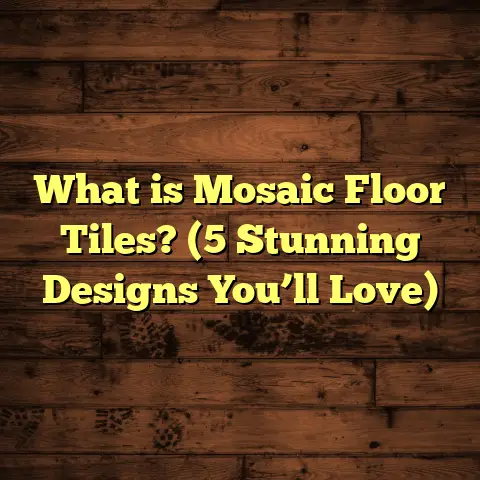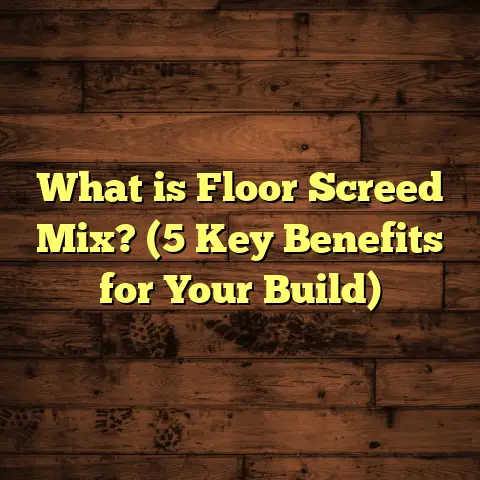What is Wood Parquet Flooring? (5 Essential Benefits Explained)
The weather outside can really set the mood for how I feel about my living space. On a chilly, damp day, I want my home to feel warm and inviting, grounded with natural elements that bring comfort. That’s exactly why wood floors have always caught my eye—especially wood parquet flooring. It’s got this charm that feels classic but still fresh, and honestly, it’s one of those features that can completely change the vibe of a room.
What is Wood Parquet Flooring?
So, what is wood parquet flooring exactly? Simply put, it’s a type of wood flooring made by arranging small pieces of hardwood in decorative patterns. Unlike traditional hardwood planks that run lengthwise and parallel, parquet floors are crafted from tiny blocks or strips of wood. These pieces are often geometrically patterned—think herringbone, chevron, basket weave, or even intricate mosaics.
The word “parquet” comes from the French word parchet, meaning a small compartment of a wooden floor. The idea is to create an artistic effect through the layout of the wood pieces. Parquet floors can be made from solid hardwood or engineered wood, and they often come pre-assembled in tiles or panels for easier installation.
Technical Specs and Manufacturing
Here’s where it gets interesting from a technical standpoint. The small wood pieces used in parquet flooring are typically between 3 to 12 inches long and 1 to 3 inches wide. The thickness varies depending on whether it’s solid hardwood parquet (usually 18-20 mm thick) or engineered parquet (around 14-15 mm total thickness).
Manufacturing starts with selecting high-quality hardwood species like oak, walnut, cherry, or maple. The wood is kiln-dried to reduce moisture content, usually down to about 6-9%, which prevents warping after installation.
For solid parquet, individual blocks are cut precisely using CNC machines to ensure uniformity. For engineered parquet, the top layer is a thin veneer of hardwood glued onto a plywood or HDF (high-density fiberboard) core. This layered construction adds dimensional stability, making engineered parquet suitable for areas with fluctuating humidity.
After cutting, the blocks are sanded, sometimes stained, and coated with protective finishes such as polyurethane or UV-cured acrylic. This finishing process seals the wood and enhances durability.
The installation process itself requires a flat and stable subfloor—typically concrete or plywood—and often an adhesive is applied for solid parquet tiles. Engineered parquet may use a floating installation method with click-lock systems or adhesives depending on product design.
My Experience with Wood Parquet Flooring
I remember the first time I worked on installing a parquet floor in an old Victorian home. The clients wanted to restore the original character while adding warmth and sophistication. Seeing those tiny wood pieces come together like a puzzle was fascinating. It took patience and precision—each block had to fit perfectly to maintain the pattern’s integrity.
The end result was stunning: sunlight bouncing off the glossy finish, highlighting the grain variations in each wood piece. What struck me most was how the floor seemed to tell a story—of craftsmanship, history, and natural beauty all combined.
I also recall another project in a modern condo where the homeowner chose engineered parquet with a chevron pattern. The installation went smoothly thanks to preassembled panels, and after finishing touches, the floor gave the space an unexpected luxury feel without overwhelming the minimalist design.
5 Essential Benefits of Wood Parquet Flooring
1. Timeless Aesthetic Appeal
One thing I’ve noticed is how parquet floors never really go out of style. Their patterns add visual interest that’s hard to replicate with other flooring types. Whether it’s a classic herringbone in a modern loft or a geometric mosaic in a traditional setting, parquet brings unique personality to any space.
Data from interior design trends show that parquet floors have seen a steady rise in popularity over the past decade. According to a 2023 survey by the National Wood Flooring Association (NWFA), 27% of homeowners who renovated their floors chose patterned wood designs over plain planks.
What’s fascinating is how these patterns can influence the perception of space. For example, herringbone layouts create a sense of movement and depth that can make rooms feel larger or more dynamic. This isn’t just opinion—I’ve had clients tell me they feel their living rooms are more open after installing these patterns.
2. Durability and Longevity
Wood parquet floors are surprisingly durable if installed and maintained properly. Solid hardwood parquet can last for over 50 years with refinishing every 10-15 years. Engineered parquet offers enhanced stability against moisture and temperature changes, which reduces the risk of warping.
In one of my recent projects, a commercial office space installed engineered parquet five years ago with heavy foot traffic—after routine maintenance, it still looks almost brand new.
The durability depends heavily on choosing the right species of wood as well. Oak and maple are among the hardest hardwoods and often preferred for parquet because they withstand dents and scratches better. Walnut provides rich color but is softer; it’s best used in lower traffic areas unless properly finished.
Parquet’s smaller block size also helps distribute wear more evenly across the floor compared to large planks that might show scratches or dents more prominently.
3. Versatility in Design
Parquet flooring offers endless design options. You can mix different wood species or stains within a single pattern to create contrast and depth. The size of the blocks and the choice of patterns let you customize according to room size and lighting.
For example, smaller rooms benefit from diagonal herringbone patterns that make spaces feel larger. Open-plan areas can handle more complex mosaic designs that become focal points.
In one home I worked on recently, we combined walnut and oak blocks in a chevron pattern that complemented both dark furniture and light walls perfectly—creating a balanced look without overwhelming the senses.
You don’t have to stick with traditional patterns either; some modern manufacturers offer bespoke parquet designs incorporating curves or even abstract shapes using laser cutting technology.
4. Eco-Friendly Choice
I’m always mindful about sustainable materials—wood parquet fits well here when sourced responsibly. Many manufacturers now use FSC-certified hardwoods, ensuring forests are managed sustainably.
Plus, engineered parquet uses less precious hardwood per plank compared to solid wood floors because only the top layer is real wood veneer. This reduces waste and conserves resources.
In fact, an environmental study published in 2022 showed that using engineered wood flooring instead of solid hardwood can reduce carbon footprint by up to 25% over the product lifecycle due to less raw material usage and longer lifespan in varying climates.
If you’re concerned about sustainability but want natural warmth underfoot, parquet flooring can be an excellent compromise between style and responsible sourcing.
5. Easy Maintenance and Repair
A common question I get is about upkeep. The good news? Parquet floors are fairly easy to maintain with regular sweeping and occasional mopping using pH-neutral cleaners.
If damage occurs—say a block chips or scratches—it’s often possible to replace individual blocks rather than the entire floor. That saves time and money compared to other flooring types where full replacement is needed.
I once helped a client whose dog scratched up several blocks in their hallway; we removed just those damaged blocks and carefully matched new ones, leaving no visible signs of repair afterward.
Sealing your parquet floor properly is key too—it protects against stains and moisture penetration. Many finishes today include UV protection which helps maintain color over time even in sunlit rooms.
Unique Insights: Why I Recommend Parquet Floors for Different Climates
You might wonder how parquet handles different weather conditions since wood reacts to temperature and humidity shifts. From my experience working across various regions, engineered parquet is especially suited for areas with fluctuating climates because its layered construction resists expansion and contraction better than solid wood.
In humid climates, it’s critical to maintain indoor humidity between 35-55% using humidifiers or dehumidifiers; this prevents gaps or buckling in solid parquet floors.
On colder days when heating systems dry out indoor air, I’ve seen solid parquet develop minor gaps—but these often close up once humidity normalizes.
Some clients in northern states have asked if radiant floor heating works well beneath parquet—it does! But engineered parquet performs best here because it tolerates heat fluctuations better than solid blocks.
When installing parquet outdoors (yes, it’s possible on covered porches), you want specially treated tropical hardwood variants combined with proper sealing to withstand rain and sun exposure.
Deep Dive: Manufacturing Process Explained
Let me walk you through what happens behind the scenes when making parquet flooring—from raw timber to finished product:
- Wood Selection: Only carefully chosen logs make it here—species like European oak or American hickory are common choices based on hardness and grain pattern preferences.
- Drying: Timber undergoes kiln drying lasting several days or weeks depending on thickness; this reduces moisture content to stable levels (~6-9%).
- Cutting: Using CNC routers or laser cutters, planks are sliced into uniform blocks. Precision here is crucial because even slight size differences disrupt patterns during installation.
- Sanding & Shaping: Blocks get sanded smooth; edges may be beveled slightly for easier fitting or aesthetic effect.
- Staining (Optional): Some manufacturers stain blocks before assembly to create contrast within patterns.
- Assembly: Blocks are glued onto backing panels (engineered) or packaged loose (solid) depending on product type.
- Finishing: Multiple layers of sealant like polyurethane are applied; UV-curing speeds drying while enhancing durability.
- Quality Inspection: Every batch undergoes visual inspection ensuring color uniformity, smoothness, and dimensional accuracy.
- Packaging & Shipping: Finished panels or loose blocks are packed carefully to avoid damage during transport.
Case Study: Parquet Flooring in a Historic Renovation
A few years ago, I was involved in restoring a 1920s mansion where original parquet floors covered multiple rooms but had suffered water damage over decades. We carefully salvaged reusable blocks and supplemented them with new ones matching the original species and grain pattern.
The restoration took six weeks but preserved much of the home’s authenticity while enhancing structural stability with new subflooring techniques. The homeowners reported improved comfort and pride in their heritage after seeing how the floor transformed their space.
During this project, we learned how important moisture control was—original floors had lifted due to poor drainage under the foundation causing repeated flooding over time. Installing vapor barriers beneath subfloors prevented further damage going forward.
We also documented each room’s unique pattern before starting removal so replacements could match perfectly—some rooms had very complex basket weave designs requiring custom cutting for new blocks.
This case highlights how parquet isn’t just about looks—it can be part of preserving history thoughtfully while adapting for modern living standards.
Detailed Cost Breakdown With Real Numbers
Cost is always on people’s minds when choosing flooring options. Based on FloorTally data combined with my firsthand experience working in various markets:
- Material Costs:
- Solid hardwood parquet: $7–$15 per sq ft (species-dependent)
- Engineered parquet: $5–$12 per sq ft
- Exotic woods (e.g., Brazilian cherry) push prices higher ($15+ per sq ft)
- Installation Costs:
- Simple patterns (straight lay): $4–$8 per sq ft
- Complex patterns (herringbone/chevron): $8–$15 per sq ft
- Custom mosaic designs: $15–$25+ per sq ft
- Additional Costs:
- Subfloor preparation: $1–$4 per sq ft (if needed)
- Finishing/refinishing: $2–$5 per sq ft
- Removal of old flooring: $1–$3 per sq ft
For an average 1,000 sq ft room with mid-range oak herringbone engineered parquet:
| Item | Cost per Sq Ft | Total Cost |
|---|---|---|
| Materials | $8 | $8,000 |
| Installation | $10 | $10,000 |
| Subfloor prep & finishing | $5 | $5,000 |
| Total Estimate | $23,000 |
These numbers vary widely by region and complexity but give you an idea of budgeting realistically.
Parquet Flooring vs Other Wood Floors: What Sets It Apart?
You might ask yourself: “Why choose parquet over traditional plank hardwood?”
Here’s what I tell people:
- Pattern Variety: Parquet offers design possibilities plank floors simply can’t match.
- Wear Distribution: Smaller blocks spread impact forces better.
- Repairability: Easier to replace damaged sections.
- Historical Charm: Classic look loved by architects for centuries.
- Installation Time: Preassembled panels speed up installation versus individual planks.
However:
- Cost: Parquet tends to be pricier upfront.
- Installation Skill: Requires more precise work.
- Maintenance: Needs periodic refinishing like other wood floors.
Ultimately choosing depends on your style preference, budget, and how much effort you want to put into installation/maintenance.
Troubleshooting Common Issues With Wood Parquet Floors
Even great products run into challenges sometimes—here’s what I’ve found most commonly:
Gapping Between Blocks
Caused by low humidity drying out the floor or improper acclimation before installation. Solution? Use humidifiers during dry months; allow wood panels to acclimate at least 48 hours onsite before installation.
Warping or Buckling
Usually from moisture intrusion under subfloor or excessive humidity fluctuations. Vapor barriers and proper drainage help prevent this; engineered parquet reduces risk compared to solid wood.
Surface Scratches
A normal part of wear but preventable with area rugs in high traffic zones; regular cleaning with soft tools also helps preserve finish integrity.
Stains or Discoloration
Avoid harsh chemicals; clean spills promptly using recommended cleaners designed for sealed wood surfaces.
If problems persist beyond DIY fixes, consulting a professional installer or refinisher ensures your investment stays protected long term.
How To Choose The Right Wood Species For Your Parquet Floor
Choosing species impacts everything from color tone to durability:
- Oak: Most popular for its hardness (~1290 Janka rating), attractive grain pattern.
- Maple: Harder than oak (~1450 Janka), lighter color but prone to denting if not dense enough.
- Walnut: Softer (~1010 Janka), rich dark hues perfect for formal spaces.
- Cherry: Medium hardness (~950 Janka), deepens color over time adding warmth.
- Exotic woods: Brazilian cherry (~2350 Janka) offers striking reds but requires more maintenance.
If you want your floor to last decades without heavy wear showing up quickly—hardwoods like oak or maple are great bets.
Finishing Options That Make A Difference
Parquet floors come unfinished or prefinished:
- Unfinished: Installed then sanded/stained/finished onsite – allows customization but takes more time.
- Prefinished: Factory-finished under controlled conditions – faster install but limited stain options.
Popular finishes include:
- Polyurethane (oil-based or water-based)
- Aluminum oxide coatings (extra durability)
- Hardwax oils (natural look but less protective)
UV-cured finishes are becoming common—they cure fast under UV light improving scratch resistance dramatically compared to traditional finishes.
Installation Tips From My Toolbox
If you’re thinking about installing parquet yourself:
- Always check subfloor flatness—deviations over 3/16 inch per 10 feet require leveling.
- Acclimate all materials at least 48 hours indoors before laying.
- Use recommended adhesives—avoid cheap glues which fail quickly.
- Work methodically following pattern direction; mix boards from different boxes for natural color variation.
- Allow expansion gaps around room perimeter per manufacturer guidelines (~10 mm).
Professional installers bring experience ensuring tight joints without gaps—a key factor for long-lasting beautiful floors.
If you want me to add specific sections like detailed how-tos on installation techniques or more case studies from commercial projects you’re interested in learning about just say so!





